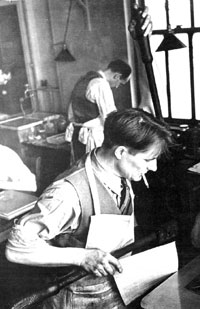Stanley William Hayter facts for kids
Quick facts for kids
Stanley William Hayter
|
|
|---|---|

Hayter, printmaking
|
|
| Born | 27 December 1901 London, England
|
| Died | 4 May 1988 (aged 86) Paris, France
|
| Education |
|
| Occupation |
|
| Known for |
|
| Movement |
|
| Awards |
|
| Signature | |
 |
|
Stanley William Hayter (born December 27, 1901 – died May 4, 1988) was an amazing English artist. He was a talented painter and a master printmaker. This means he was an expert at creating art using printing techniques.
In the 1930s, Hayter was connected to a style called surrealism. This art style explores dreams and imagination. Later, from 1940, he became part of abstract expressionism. This style uses colors and shapes to show feelings, not realistic pictures.
Many people think Hayter was one of the most important printmakers of the 1900s. In 1927, he started a famous art studio in Paris called Atelier 17. After he passed away in 1988, the studio became known as Atelier Contrepoint. Many famous artists worked there, including Pablo Picasso, Joan Miró, Jackson Pollock, and Wassily Kandinsky.
Hayter was also known for inventing a cool new way of printing called viscosity printing. This method lets artists put three or more colors on one printing plate at the same time. It uses different thicknesses of ink to make the colors stick in specific ways.
He was also a very active painter. One art expert, Bryan Robertson, said that Hayter created some of the most important art of his time. He worked with painting, drawing, engraving, and other art forms.
Contents
Early Life and Learning
Stanley William Hayter was born in Hackney, London, on December 27, 1901. His father, William Harry Hayter, was also a painter.
Stanley first studied science, getting a degree in chemistry and geology from King's College London. From 1922 to 1925, he worked for an oil company in Iran.
After getting sick with malaria, Hayter came home. His company showed the paintings and drawings he made while overseas. Almost all his paintings sold! This success likely helped him decide to become a full-time artist.
His Art Career
Starting in Paris
In 1926, Hayter moved to Paris, France. He studied art for a short time at the Académie Julian. That same year, he met a Polish printmaker named Józef Hecht. Hecht taught Hayter how to engrave on copper using a special tool called a burin.
Hecht helped Hayter get a printing press. Hayter wanted to create a studio where artists of all levels could work together. They could explore and learn about engraving. In 1927, he opened this studio. In 1933, it moved to a new address and became famous as Atelier 17.
Hayter worked with many artists, helping them try printmaking. Famous artists like Miró, Picasso, and Kandinsky even made prints together there. They created art to help raise money for people during the Spanish Civil War.
Moving to New York City
When World War II started, Hayter moved Atelier 17 to New York City. He also taught printmaking at the New School. Artists like Jackson Pollock and Mark Rothko made prints at the New York Atelier 17.
During the war, Hayter developed his "simultaneous color printing" method. This is where he added colors to printing plates in new ways. For example, he might use rags soaked in colored ink or roll a thick ink over a thinner one. The thicker ink would only stick to certain parts of the plate.
Back to Paris
In 1950, Hayter returned to Paris and brought Atelier 17 with him. He was a very busy printmaker, creating over 400 printed artworks before he passed away.
He also wrote books about printmaking. His book, New Ways of Gravure, came out in 1949. Another book, About Prints, was published in 1962.
Hayter kept developing his painting alongside his printmaking. His interest in automatism (creating art without planning) led him to work with the Surrealists. In the United States, he was a leader in the Abstract Expressionism movement.
His ideas about printmaking greatly influenced how it was taught in America. He believed in creating prints without too many detailed drawings beforehand. He also liked strong plate tone (the way ink is left on the plate) and trying new things as you worked.
In 2005, the Tate Archive, a famous art collection, got Hayter's personal papers.
Personal Life
Stanley Hayter was married three times. He had three sons. His first son, Patrick, passed away when he was young. His other two sons, Augy and Julian, were from his second marriage to Helen Phillips. Augy was an actor, writer, and translator, and Julian was a composer, musician, and photographer. Both Augy and Julian have also passed away.
Awards and Honors
Stanley William Hayter received many awards for his amazing art and contributions:
- 1951 – He was made an Officer of the Order of the British Empire (OBE).
- 1951 – The French government gave him the Légion d'honneur, a very high award.
- 1958 – He was chosen to represent Great Britain at the Venice Biennale, a big art show.
- 1967 – He was made a Chevalier des Arts et des Lettres, another French honor.
- 1968 – He was promoted to Commander of the Order of the British Empire (CBE).
- 1972 – He received the Grand Prix des Arts de la Ville de Paris, a major award from the city of Paris.
- 1978 – He was chosen as an honorary member of the American Academy of Arts and Science.
- 1982 – He became an honorary member of the Royal Academy.
- 1983 – He received honorary doctorates from two universities in the USA.
- 1986 – He was promoted again in the Ordre des Arts et des Lettres, becoming a Commandeur.

